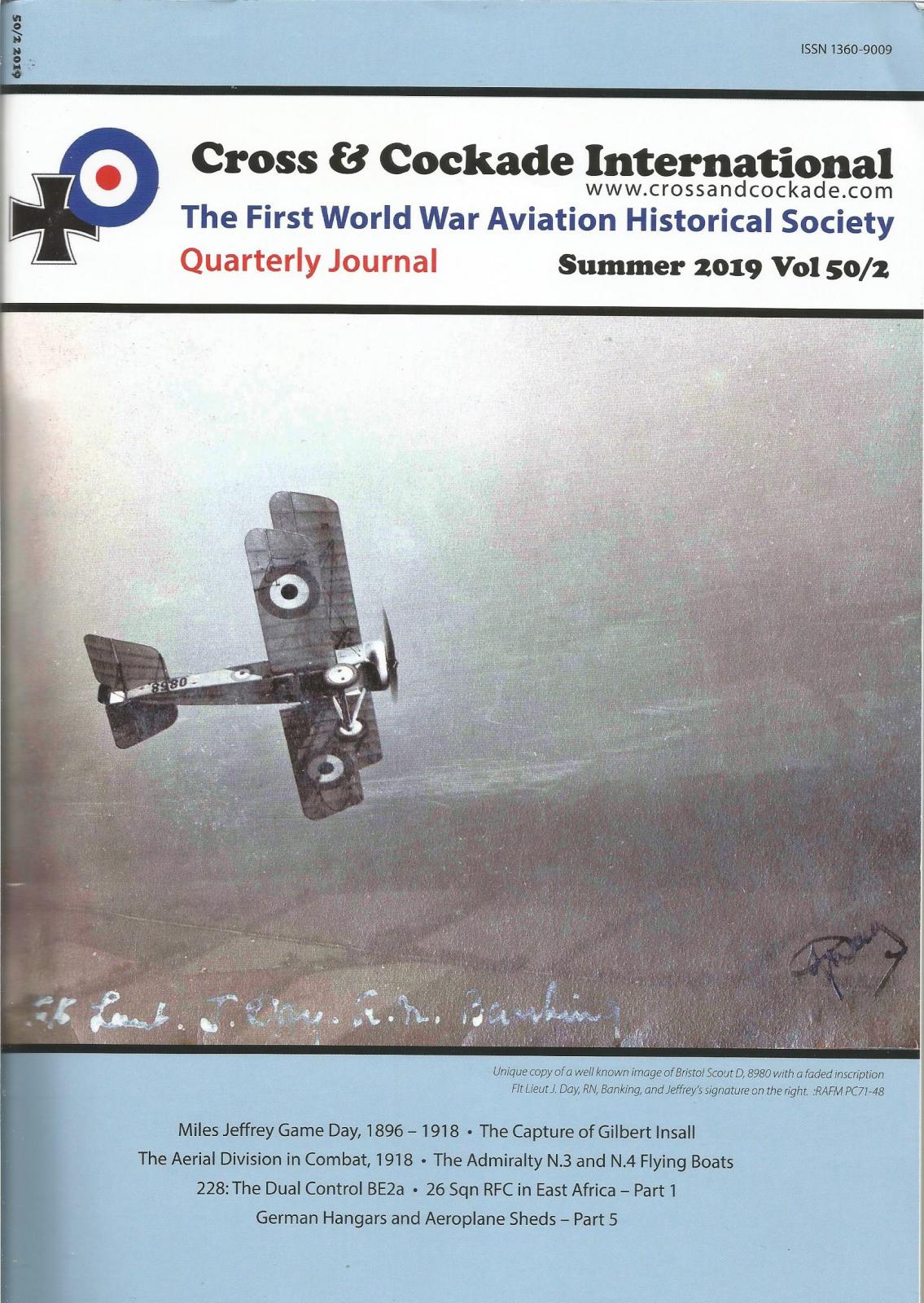Cross & Cockade Int. Quarterly Journal, Summer 2019
Cross & Cockade International is a non-profit UK based group known as the First World War Aviation Historical Society that publishes their journal four times a year. They also provide a free newsletter. Those interested in the newsletter can subscribe by visiting the C&CI website.
The "lead" article, "Miles Jeffrey Game Day 1896-1918?" by Ian Burns, traces the too-short life of Jeffrey Day. Day was a pilot known for his ability to handle aircraft which had rather skittish flight characteristics. Day was also a talented poet, and this article features some text penned by Day. Day was involved in a rather risky project involving a seaplane and a Bristol Scout, the Scout piggybacking on the upper wing of the Porte Baby. The article is supported with some stunning photographs of the aircraft, ships, and other personnel that played a part in Day’s experiences.
A short article follows the "Jeffrey Day" story. Gilbert Insall was shot down twice and captured on the second shoot-down by the Germans. He eventually escaped. During his service, Insall was awarded the Victoria Cross and for his successful escape, he was awarded the Military Cross. The article includes a copy of Insall’s Action Report regarding his shoot down and the medical treatment Insall received. Pointed out in the article is the view that Insall was rather self-serving in his reports and behavior. The article is supported with photographs on Insall and various aircraft.
The article entitled, "The Aerial Division In Combat, 1918", by David Mechin, addresses the administrative and organizational aspect of aerial combat rather than the pilots who flew the planes. In this regard, this article details the contributions made by General Maurice Duval to the French air arm. Under Duval’s leadership and guidance aerial production was reorganized, with unsuitable aircraft being removed from the front, replaced by better designs. Duval also changed the concentration of aerial assets on the front. Duval’s leadership made a major difference to the Michael Offensive and during the second battle of The Marne.
The N.3 and N.4 Flying Boats were under development when the Armistice brought about an end to combat. While work on some aircraft under development at this time was terminated, work on these large aircraft continued. "The Admiralty N.3 and N.4 Flying Boats", by Colin A. Owers, follows the rather complex history of these aircraft. What makes this article significant to this reviewer is what is known as the "Southampton hull" is at the RAF Museum, Hendon, a museum recently visited by this reviewer.
Some articles focus on individual pilots or persons, some focus on particular battles, and some focus on a squadron or flying group. This next article, "228: The Dual Control BE2a by Paul R. Hare", focuses on a specific aircraft, namely a BE2a identified as Nbr. 228. 228 did not see combat, nor did it have a long and distinguished service life. Delivered on or near Aug 29, 1913, Nbr. 228 was deleted from service on September 11, 1914. In between those dates the aircraft appears to have served in a satisfactory manner. The article is accompanied by some high-quality images of 228.
The RFC had a presence in East Africa, and the article by Mike O’Connor and Ray Vann highlights the history of 26 Squadron stationed in East Africa. This is Part 1 of a multi-part series of articles by O’Connor and Vann and is supported by a number of excellent images of personnel, aircraft, and the unique environment in which the Squadron served.
"German Hangars and Aeroplane Sheds, Part Five via Barry Gray, provides another in a series of articles highlighting various structures found on German airfields. Photographs and high-quality illustrations provide an excellent resource for those who wish to model such historical structures.
"Logbook" compiled by Mick Davis presents a series of photographs and text covering the Unit Markings of 15 Reserve/Training Squadron.
For the modeler, Joe Moran has compiled a list of new releases and kit reviews highlighting the AZmodel kit of the Hansa Brandenburg B.1. and a review of the Fly Ansaldo S.V.A.9
Mick Davis, Managing Editor of C&C, provides feedback to readers on various topics.
This publication concludes with a description of two new publications which focus on World War I aviation, and 8 full color profile illustrations on the inside of the back cover, and on the back cover, itself, to accompany his article, "The Aerial Division in Combat, 1918"
Contents
- Miles Jeffrey Game Day 1896-1918 by Ian Burns
- The Capture of Gilbert Insall by A.D. Harvey
- The Aerial Division In Combat, 1918 by David Mechin
- The Admiralty N.3 and N.4 Flying Boats by Colin A. Owers
- 228: The Dual Control BE2a by Paul R. Hare
- 26 Sqn RFC in East Africa – Part 1 by Mike O’Connor and Ray Vann
- German Hangars and Aeroplane Sheds, Part Five via Barry Gray
- Logbook 15 Reserve/Training Squadron: Unit Markings by Mick Davis
- Modeling: New Releases and Kit Reviews compiled by Joe Moran
- Fabric: Queries and Feedback compiled by Mick Davis
This publication is highly recommended due to the excellent articles based on primary source documentation accompanied by many black and white images. If you are into early / WWI aviation; this journal is an incredible source of information that will have you on the edge of your seat for the next issue. Thanks to Cross & Cockade International and IPMS/USA for the chance to review this great issue.
Several pages in this issue can be viewed online as pdf files by going to: https://greatwaraviation.org




Comments
Add new comment
This site is protected by reCAPTCHA and the Google Privacy Policy and Terms of Service apply.
Similar Reviews